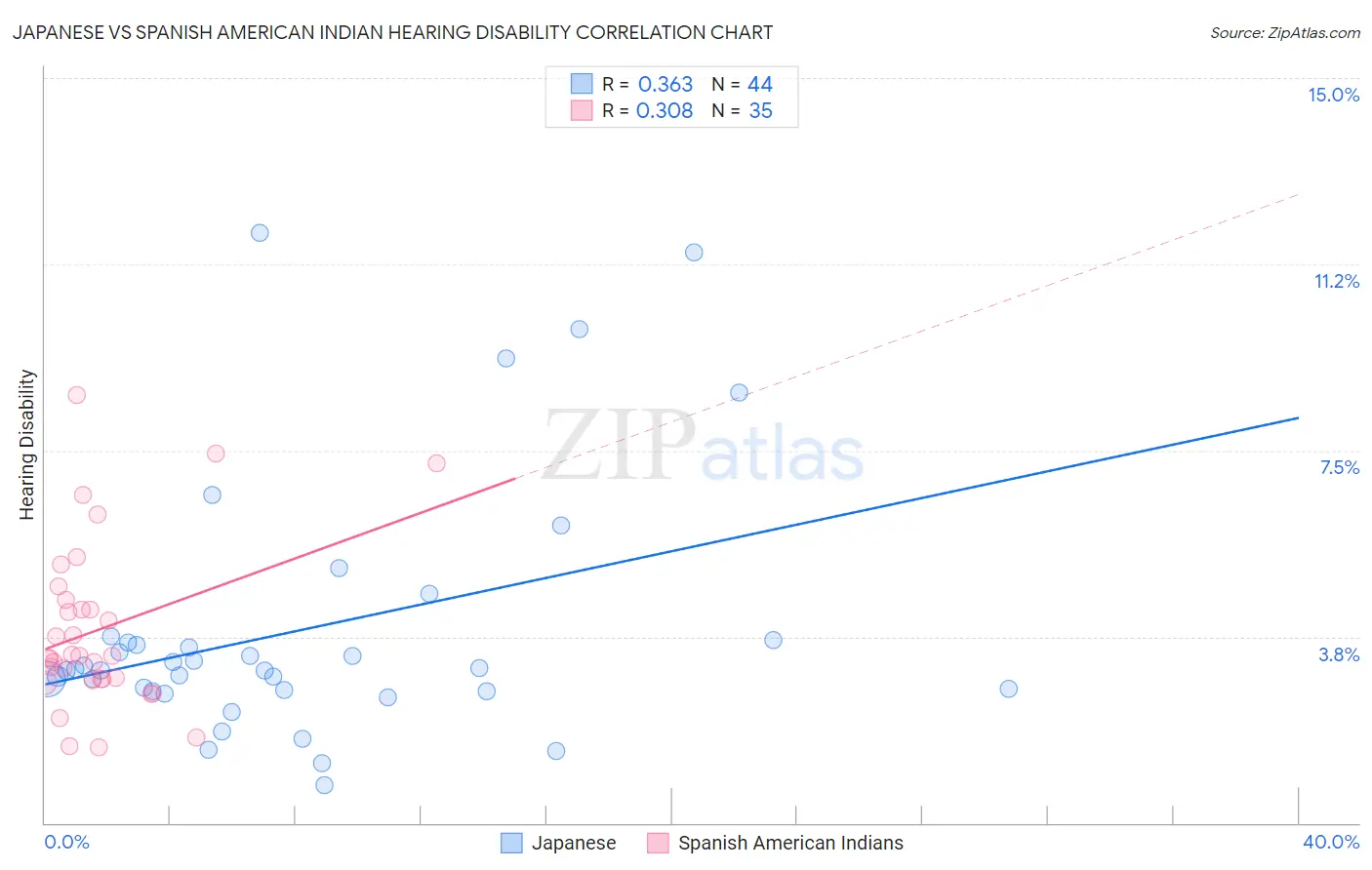Japanese vs Spanish American Indian Hearing Disability
COMPARE
Japanese
Spanish American Indian
Hearing Disability
Hearing Disability Comparison
Japanese
Spanish American Indians
3.0%
HEARING DISABILITY
46.0/ 100
METRIC RATING
178th/ 347
METRIC RANK
3.1%
HEARING DISABILITY
24.1/ 100
METRIC RATING
195th/ 347
METRIC RANK
Japanese vs Spanish American Indian Hearing Disability Correlation Chart
The statistical analysis conducted on geographies consisting of 249,105,269 people shows a mild positive correlation between the proportion of Japanese and percentage of population with hearing disability in the United States with a correlation coefficient (R) of 0.363 and weighted average of 3.0%. Similarly, the statistical analysis conducted on geographies consisting of 73,148,341 people shows a mild positive correlation between the proportion of Spanish American Indians and percentage of population with hearing disability in the United States with a correlation coefficient (R) of 0.308 and weighted average of 3.1%, a difference of 2.3%.

Hearing Disability Correlation Summary
| Measurement | Japanese | Spanish American Indian |
| Minimum | 0.75% | 1.5% |
| Maximum | 11.9% | 8.6% |
| Range | 11.1% | 7.1% |
| Mean | 3.9% | 3.9% |
| Median | 3.1% | 3.4% |
| Interquartile 25% (IQ1) | 2.7% | 2.9% |
| Interquartile 75% (IQ3) | 3.7% | 4.5% |
| Interquartile Range (IQR) | 1.0% | 1.6% |
| Standard Deviation (Sample) | 2.6% | 1.7% |
| Standard Deviation (Population) | 2.6% | 1.7% |
Demographics Similar to Japanese and Spanish American Indians by Hearing Disability
In terms of hearing disability, the demographic groups most similar to Japanese are Immigrants from Philippines (3.0%, a difference of 0.040%), Panamanian (3.0%, a difference of 0.10%), Immigrants from Moldova (3.0%, a difference of 0.28%), Immigrants from Sweden (3.0%, a difference of 0.34%), and Immigrants from Belgium (3.0%, a difference of 0.43%). Similarly, the demographic groups most similar to Spanish American Indians are South African (3.1%, a difference of 0.050%), Immigrants from Europe (3.1%, a difference of 0.16%), Macedonian (3.1%, a difference of 0.35%), Korean (3.1%, a difference of 0.42%), and Immigrants from Switzerland (3.1%, a difference of 0.56%).
| Demographics | Rating | Rank | Hearing Disability |
| Panamanians | 47.0 /100 | #176 | Average 3.0% |
| Immigrants | Philippines | 46.4 /100 | #177 | Average 3.0% |
| Japanese | 46.0 /100 | #178 | Average 3.0% |
| Immigrants | Moldova | 43.1 /100 | #179 | Average 3.0% |
| Immigrants | Sweden | 42.4 /100 | #180 | Average 3.0% |
| Immigrants | Belgium | 41.5 /100 | #181 | Average 3.0% |
| Immigrants | Italy | 41.1 /100 | #182 | Average 3.0% |
| Bulgarians | 39.7 /100 | #183 | Fair 3.0% |
| Immigrants | Ireland | 37.4 /100 | #184 | Fair 3.0% |
| Immigrants | Southern Europe | 35.3 /100 | #185 | Fair 3.0% |
| Immigrants | Mexico | 34.9 /100 | #186 | Fair 3.0% |
| Blacks/African Americans | 34.7 /100 | #187 | Fair 3.0% |
| Mexican American Indians | 34.7 /100 | #188 | Fair 3.0% |
| Africans | 32.9 /100 | #189 | Fair 3.0% |
| Immigrants | South Africa | 31.1 /100 | #190 | Fair 3.1% |
| Immigrants | Switzerland | 28.8 /100 | #191 | Fair 3.1% |
| Koreans | 27.6 /100 | #192 | Fair 3.1% |
| Macedonians | 27.0 /100 | #193 | Fair 3.1% |
| South Africans | 24.5 /100 | #194 | Fair 3.1% |
| Spanish American Indians | 24.1 /100 | #195 | Fair 3.1% |
| Immigrants | Europe | 22.9 /100 | #196 | Fair 3.1% |